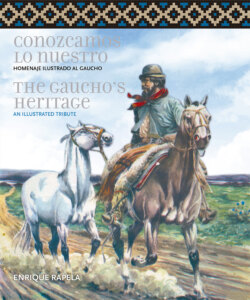Читать книгу Conozcamos lo nuestro - The Gauchos's Heritage - Enrique Rapela - Страница 28
На сайте Литреса книга снята с продажи.
f Rastra
ОглавлениеThe gaucho’s attire was complemented frequently with another luxury: the rastra, accessory that served to buckle the belt with which the countryman fastened the ensemble of breeches and chiripá around the waist. Usually, it was made of a silver plate of different shapes and ornaments; in the case of an estanciero, most of the time, the ornament consisted of the mark of his estancia (A); or any other Creole motif.
There were rastras that were true jewels, the work of great silversmiths. In the case of wealthy countrymen, this buckle was adorned with patacones and other valued coins. Buenos Aires had great artists in the chiseling of silver and gold, like Serantes, Castillo and Machado.
The rastra itself was secured to the belt or tirador by coins, buttons or silver patacones attached to it by plates or chains. The poorest gauchos who could not afford to have a rastra used to hold the belt with a simple leather strap with a button in the end or a simple knot. This will be seen more clearly when we talk about the flank knife.
This set of belt and rastra held everything in place, along with the sash (B). The chiripá has no pockets and, frequently, the countryman has no jacket or coat, pieces of clothing that do have pockets. Therefore, usually the tirador, that is, a wide belt made of tanned hide, had pockets inside or outside, and the gaucho kept his money there. The truth is that it was not necessary a big pocket, because there was not much to put inside; but the gaucho wore it with ease and grace (C).
The Creole had little appreciation of money. Already Félix de Azara, a great observer, had said:
“(…) they do not appreciate money a lot (…) They do not drink wine but aguardiente and their custom is to fill a big glass and invite those present, passing it from hand to hand and repeating that until the money of the person who invited is finished, considering rude not to drink when have been invited”.
It’s understandable this way of being for the countryman, a dream of the infinite that were that endless Pampas he roamed at his will and that gave him everything he needed to live. His ingenuity and his skills with weapons allowed him to clothe, to eat and to get refuge; the land, the water and the hide gave him an accommodation he roofed with straw. The mix of races coming from places where living was hard gave them some notion of savings, but not too much. This explains the disappearance of great fortunes.
